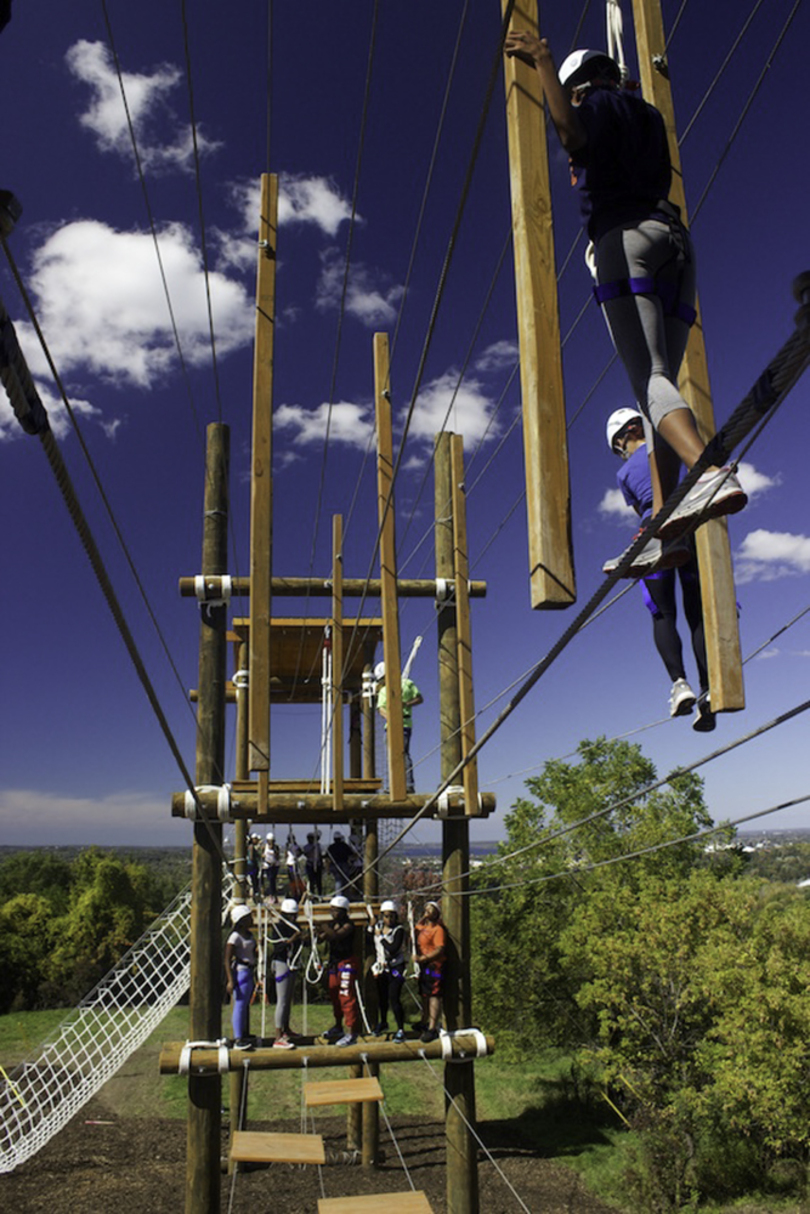Challenge accepted: Following first run, South Campus ropes course turnout satisfies Syracuse University
With a successful initial run, the Syracuse University challenge course hasn’t had any trouble roping in customers.
“We had quite a few weekends where we were chock-full up there, which was really nice. And that was just in the initial opening three months,” said Scott Catucci, SU’s associate director for outdoor education and student development. “So we’re very, very happy and excited about that.”
The course is a mix of giant wood towers, nets and low- and high-rope elements, and sits atop a hill on South Campus that overlooks Syracuse, not far from the Inn Complete. It generally operates between April 15 and Nov. 15 — but that mostly depends on the weather — and is intended to be an educational and team-building experience. The first program of 2014 at the course was supposed to be held last Sunday, but it was rained out. Training will be held this weekend.
The first official program at the course was held Sept. 27 and the last on Nov. 16. During this time, 466 students used the course in 13 programs, Catucci said. Two outside groups — 130 students in total from a middle school and a high school sports team — also used the course during that time, he said.
The goal for the course is to have as many people use it as possible, Catucci said, and recreation services couldn’t have held any more weekend programs last fall. The course, he said, benefits the entire community.
Each program at the course is custom built for the group using it, he said. For example, if a group wants to work on trust and communication, recreation services will try to tailor a session with activities that bring out these skills.
The course costs $25 or $35 to SU students for the half- and full-day program, respectively, and has to be reserved in advance. The minimum number of people needed to use the course is 15. But if there are fewer people, a group will be charged that rate. Outside groups have to pay more to use the course.
Catucci has said he’s heard talk about bringing a ropes course to campus dates as far back as 1998. Part of the reasoning for building the course was because SU students were traveling to other places to use them, he said.
“Let’s say, students come into Syracuse and we send them to Cornell to have an amazing experience on their challenge course — that we think is important, but that we don’t provide,” he said. “To me, it’s a no-brainer.”
It’s still unclear how much the course and the accompanying outdoor education center cost to build. As a private institution, SU does not have to disclose any information about the project, though interviews and public records give some insight into the cost.
Joe Lackey is the owner of Alpine Towers International, an Asheville, N.C.-based company that specializes in the design, engineering and installation of challenge courses.
Alpine worked under GHD, a global engineering, architecture and environment company that has an office in Syracuse, to build the course, Lackey said.
Lackey said similar courses to the one at SU fall in the $200,000–300,000 range. The Odyssey-style course, as it’s called, is close in price to one at the University of Arizona, he said.
Arizona was invoiced $202,808 after tax for its course, and a building permit for SU’s outdoor education center lists the estimated construction cost of the building as $556,000. SU’s budget for 2014 fiscal year is about $1.2 billion.
Proponents of challenge courses say these places provide experiences that relate to everyday life.
Each element of these courses — hence the name — is designed to make people overcome a particular challenge, said James Borishade, executive director of the Association for Challenge Course Technology, an industry trade group headquartered in Deerfield, Ill. While people fear failure, he said, these courses show that success is just around the corner.
“It’s really a metaphor to life,” he said.
Carolyn Fine, a senior advertising major who used the course two times last fall through the Panhellenic Council — a sorority governing body — said having the course on campus was one of its draws. Fine said she was interested in the course before it had even opened.
Fine first used the course with a group of about 80 people, which proved difficult since the course isn’t that large, she said. But with a smaller group the second time around, everyone was able to use all of the elements of the course. The activities both on the ground and on the course help people work together, she said.
Fine said it might be expensive for some groups to use the course — she did a half-day program each time — but that it was a worthwhile experience.
“It was just a good time — something to do with a group,” she said. “You definitely get closer to people.”
Lindsey Silverman, a junior advertising and information management and technology major, used the course with her sorority, Alpha Gamma Delta. She said it was AGD’s second year in a row doing a retreat at a challenge course. It was a positive experience, she said, and this time members didn’t have to go off campus.
Silverman estimated that about 100 people went. She said the course allows users to get to know people they don’t know as much, and that it really lifts the spirit of any group or club.
“It was great,” she said. “I mean, I love that kind of stuff, I love all the team-building activities. Even if they’re cheesy, I think they’re really fun.”
Published on April 2, 2014 at 1:40 am
Contact Dylan: dmsegelb@syr.edu | @dylan_segelbaum








